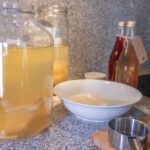As much as we would like to grow our herbs outdoors, not everyone has the luxury of space, time, and good weather. But what if we told you that you can grow herbs indoors without sunlight? Yes, it is possible! In this article, we will guide you through the essential steps in growing herbs indoors without sunlight successfully.
What Herbs Can You Grow Indoors Without Sunlight?

Before we dive into the tips and tricks of growing herbs indoors without sunlight, let’s discuss what herbs can thrive in low light conditions. Some of the herbs that can grow well indoors without sunlight are:
- Mint – Mint is an aromatic herb that is easy to grow indoors. It prefers moist soil and can tolerate low light conditions. You can use mint in teas, salads, and desserts.
- Parsley – Parsley is a versatile herb that can be used in soups, stews, and salads. It prefers moist soil and can tolerate low light conditions.
- Thyme – Thyme is a fragrant herb that is perfect for seasoning meats, vegetables, and sauces. It prefers well-draining soil and can tolerate low light conditions.
- Oregano – Oregano is a popular herb that is used in Mediterranean and Mexican cuisines. It prefers well-draining soil and can tolerate low light conditions.
- Chives – Chives are a member of the onion family and are used in soups, salads, and dips. They prefer moist soil and can tolerate low light conditions.
- Cilantro – Cilantro is a herb that is used in Mexican, Asian, and Indian cuisines. It prefers moist soil and can tolerate low light conditions.
These herbs can be grown in containers and placed near a window that receives bright, indirect sunlight. If you don’t have access to a window, you can use artificial grow lights to supplement the natural light. Keep in mind that even though these herbs can tolerate low light conditions, they still require some amount of light to grow and thrive. Therefore, it is important to choose the right location and provide them with proper care to ensure their success.
How to Care for Herbs Growing Indoors Without Sunlight
| Care Tips | Description |
|---|---|
| Watering | Herbs grown indoors without sunlight should be watered regularly. Keep the soil moist, but not too wet. |
| Soil | Use a high-quality potting mix that provides good drainage. Avoid compacted soil that can retain too much moisture. |
| Temperature | Most herbs prefer temperatures between 60 and 70 degrees Fahrenheit. Avoid placing herbs near drafty windows or heating vents. |
| Fertilizer | Use a balanced fertilizer to provide nutrients to the herbs. Follow the instructions on the package for the best results. |
| Pruning | Prune the herbs regularly to encourage new growth and prevent them from becoming too leggy. |
Creative Ways to Grow Herbs Indoors Without Sunlight
| Creative Ideas | Description |
|---|---|
| Mason Jar Herb Garden | Use mason jars to create a vertical herb garden that can be placed near a window. |
| Hydroponic Herb Garden | Use a hydroponic system to grow herbs without soil. This method can be more efficient and requires less space. |
| Hanging Herb Garden | Hang herb pots from a wall-mounted shelf or wire mesh to create a unique and space-saving herb garden. |
The Best Location for Your Indoor Herb Garden

The first step in growing herbs indoors without sunlight is to find the best location for your indoor herb garden. Even though herbs do not require direct sunlight, they still need some form of light to grow. The ideal location for your indoor herb garden is near a window that receives bright, indirect sunlight. If you do not have a window that receives indirect sunlight, you can use artificial lights, such as fluorescent or LED grow lights.
- Consider the amount of natural light: Even though some herbs can thrive in low light conditions, it’s still important to choose a location that gets as much natural light as possible. East-facing windows are ideal because they provide morning sunlight but protect plants from the harsh afternoon sun. If east-facing windows aren’t available, consider south-facing or west-facing windows, but be sure to monitor the temperature and humidity levels to prevent overheating and dryness.
- Temperature and humidity: Most herbs prefer temperatures between 60-75°F and humidity levels between 40-60%. Keep your indoor herb garden away from drafty doors or windows, heating vents, or air conditioning units. You can increase humidity levels by placing a tray of water near the plants, misting them regularly with a spray bottle, or using a humidifier.
- Adequate space: Your indoor herb garden should have enough space to allow for proper air circulation and growth. Choose a location that is not too cramped and allows room for expansion. Keep in mind that some herbs, like mint, can quickly take over a container or garden bed, so plan accordingly.
- Accessibility: Choose a location that is easy to access and allows you to check on your plants regularly. You’ll need to water them, prune them, and monitor their growth, so make sure your indoor herb garden is in a spot that is convenient for you.
- Consider artificial lighting: If natural light is limited, consider supplementing with artificial lighting. LED grow lights can provide the necessary light spectrum for plant growth and can be easily set up in a small indoor space. Be sure to choose lights that are appropriate for the size of your garden and the type of herbs you’re growing.
In summary, the best location for your indoor herb garden is one that provides adequate natural light, stable temperature and humidity levels, enough space for growth, and accessibility for regular care. Consider supplementing with artificial lighting if necessary and plan your garden layout to prevent overcrowding. With these tips in mind, you can create a thriving indoor herb garden that adds flavor and beauty to your home.
Choosing the Right Container for Your Herbs
Choosing the right container for your herbs is crucial for their growth and development. The container you choose should have good drainage to prevent waterlogging, which can cause root rot. You can use a variety of containers such as terracotta pots, plastic pots, or even recycled containers such as mason jars or tin cans.
Drainage
The container you choose should have adequate drainage holes to prevent water from pooling at the bottom, which can lead to root rot. If you’re using a decorative container without drainage holes, consider adding a layer of rocks or gravel at the bottom to improve drainage.
Size
The size of the container will depend on the type of herbs you’re growing and the space available. Some herbs, like basil and parsley, have deep root systems and require larger containers, while others, like chives and thyme, can thrive in smaller pots. Make sure the container is big enough to allow for proper growth and has enough room for the roots to spread out.
Material
Containers can be made of various materials, such as clay, ceramic, plastic, or metal. Material pros and cons vary. Clay pots are porous and allow for good airflow, but they can be heavy and breakable. Plastic pots are lightweight and durable, but they may not allow for good airflow. Consider the look you’re going for, the amount of maintenance you’re willing to do, and the amount of natural light your herbs will receive when choosing a material.
Placement
The container you choose should also be appropriate for the location where you plan to place your indoor herb garden. If you plan to put your herbs on a windowsill, consider a smaller, lighter container that won’t block the light. If you plan to place them on a table or countertop, choose a container that is more decorative and complements your home’s decor.
Watering needs
Finally, consider the watering needs of your herbs when choosing a container. Some herbs, like rosemary and thyme, prefer drier soil and may do better in a terra cotta or clay pot, which allows for better evaporation. Other herbs, like basil and mint, prefer consistently moist soil and may do better in a plastic or glazed ceramic pot, which retains moisture better.
In summary, choosing the right container for your herbs involves considering factors such as drainage, size, material, placement, and watering needs. By selecting a container that is appropriate for the type of herbs you’re growing and the location of your indoor herb garden, you can ensure that your plants thrive and add beauty and flavor to your home.
The Right Soil for Your Indoor Herbs
The right soil is critical for the growth of your indoor herbs. Herbs like well-drained, organic soil. You can use a pre-mixed potting mix or make your own by mixing equal parts of perlite, peat moss, and vermiculite.
Soil Drainage
The soil you choose for your indoor herb garden should have good drainage to prevent water from pooling and causing root rot. Look for a soil mix that includes perlite or vermiculite, which help to aerate the soil and improve drainage.
Nutrients
Your indoor herbs will need nutrients to grow and thrive. Look for a soil mix that is enriched with organic matter, such as compost or worm castings, which provide essential nutrients like nitrogen, phosphorus, and potassium. Alternatively, you can add your own organic matter to a standard potting mix.
pH
Soil pH is also essential. Most herbs prefer pH 6.0–7.0 soil. You can test the pH of your soil with a simple test kit, available at most garden centers. If the pH is too low, you can add lime to raise it, or if it’s too high, you can add sulfur to lower it.
Texture
The texture of the soil is also important. Look for a soil mix that is light and fluffy, with good aeration and moisture-holding capacity. Avoid soil mixes that are heavy or dense, which can suffocate the roots and prevent proper drainage.
Sterilization
Finally, it’s important to use soil that is free of pests and diseases. Consider using a sterilized soil mix, which has been treated to eliminate harmful bacteria, fungi, and insects. Alternatively, you can sterilize your own soil by baking it in the oven at 180 degrees Fahrenheit for 30 minutes.
Choosing the right soil for your indoor herbs involves considering factors such as drainage, nutrients, pH, texture, and sterilization. By selecting a soil mix that meets the needs of your herbs, you can ensure that they grow strong and healthy, and provide you with a fresh supply of delicious herbs all year round.
The Importance of Watering Your Indoor Herbs
Watering your indoor herbs is crucial to their survival. Overwatering can lead to root rot, while under-watering can cause the herbs to wilt and die. The best way to water your indoor herbs is to water them thoroughly when the top inch of soil feels dry to the touch.
Fertilizing Your Indoor Herbs
Fertilizing your indoor herbs is essential to ensure they receive the necessary nutrients for their growth. You can use an organic fertilizer or a water-soluble fertilizer once a month to give your herbs the necessary nutrients.
Pruning and Harvesting Your Indoor Herbs

Pruning and harvesting your indoor herbs is essential for their growth and health. Regular pruning will encourage new growth and prevent the herbs from becoming leggy. You can start pruning your herbs once they reach 6 inches in height by pinching off the top growth. Harvesting your herbs is also important to ensure they stay healthy and productive. You can harvest your herbs once they reach maturity by cutting off the stems just above the leaf node.
- Pruning: Regular pruning is essential to keep your indoor herbs healthy and productive. Pinch stem tips to promote branching and bushier growth. Remove any yellow or dead leaves, and prune back any overly long or straggly stems. You can also trim off any flowers that appear, as these can signal the end of the plant’s growth cycle.
- Harvesting: When it comes to harvesting your indoor herbs, it’s important to do so at the right time. For leafy herbs like basil, parsley, and cilantro, you can begin harvesting once the plant has developed several sets of true leaves. Use scissors or pruning shears to snip off the leaves just above a leaf node, which will encourage new growth. For woody herbs like thyme, rosemary, and sage, wait until the plant is established and has developed a sturdy stem. You can then harvest the leaves as needed, taking care not to remove more than one-third of the plant at a time.
- Drying: If you have an excess of herbs, or want to preserve them for later use, you can dry them by hanging them upside down in a cool, dry place. Store dried leaves in an airtight container. Alternatively, you can freeze your herbs by chopping them up and placing them in ice cube trays filled with water or olive oil.
- Storing: To store fresh herbs, place them in a jar or vase filled with water, like a bouquet of flowers. You can also store them in the refrigerator wrapped in damp paper towels, or in a plastic bag with a few holes punched in it to allow for air circulation. Just be sure to use them within a few days, as they will begin to lose their flavor and potency over time.
Pruning and harvesting your indoor herbs involves knowing when and how to trim back the plant to encourage growth and productivity, as well as how to properly store and preserve your harvested herbs for later use. By following these tips and techniques, you can ensure that your indoor herb garden provides you with a bountiful and delicious supply of fresh herbs all year round.
Common Problems and Solutions for Indoor Herb Gardening
Indoor herb gardening can have its share of problems. Here are some common problems and solutions to help you troubleshoot your indoor herb garden:
- Yellowing leaves: Overwatering or inadequate drainage can cause yellowing leaves. Make sure your container has good drainage, and water your herbs only when the top inch of soil feels dry to the touch.
- Pests: Common indoor herb pests include aphids, spider mites, and whiteflies. You can use organic pest control methods such as neem oil or insecticidal soap to get rid of these pests.
- Leggy growth:Low light causes leggy growth. Move your herbs to a brighter location or supplement their light with artificial grow lights.
Frequently Asked Questions (FAQs)
Can you grow herbs indoors without sunlight?
Yes, you can grow herbs indoors without sunlight. Herbs such as mint, parsley, thyme, oregano, chives, and cilantro can thrive in low light conditions.
What is the best location for an indoor herb garden?
The best location for an indoor herb garden is near a window that receives bright, indirect sunlight. If you do not have access to a window, you can use artificial grow lights.
What is the right soil for indoor herbs?
Indoor herbs prefer well-draining soil that is rich in organic matter. You can use a pre-mixed potting mix or make your own by mixing equal parts of perlite, peat moss, and vermiculite.
How often should I water my indoor herbs?
You should water your indoor herbs thoroughly when the top inch of soil feels dry to the touch. Overwatering can cause root rot, while under-watering can cause the herbs to wilt and die.
Can I use artificial grow lights for my indoor herb garden?
Yes, you can use fluorescent or LED grow lights to supplement the natural light for your indoor herb garden.
Conclusion
Growing herbs indoors without sunlight can be a fun and rewarding experience. With the right location, container, soil, and care, you can have fresh herbs at your fingertips all year round. Remember to prune and harvest your herbs regularly, and troubleshoot any problems that may arise. Happy herb gardening!

As a dedicated mother and passionate software developer, she weaves her diverse experiences into captivating stories that inspire and engage readers. Emma's love for sustainable living and environmental consciousness permeates both her personal and professional life. When she's not immersed in the world of coding and software development, Emma can be found nurturing her family and tending to her thriving organic garden. Her commitment to sustainable practices extends to every aspect of her life, from repurposing household items to embracing eco-friendly technologies.










